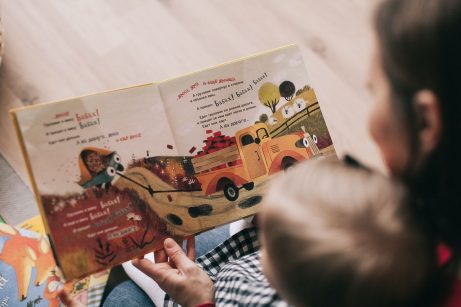Setting Up the Home Environment, Part I

In the last article, we spoke about the prepared environment as a whole. Next, we will explore setting up a home environment for each age group, starting here: with the infant.
There are endless resources available on the topic of setting up a home for a newborn baby, and most of them seem to focus one of two things. Either what to eliminate from your home – as in, “babyproofing” your home and making it safe, or what to buy – an endless list of commercial products and trappings, from the practical (a good pram or car seat) to the unnecessary but convenient (bottle warmer, odour-trapping diaper pail) to the outright ridiculous (wipe warmer or baby electronics).
This article looks, instead, on the infant’s environment from a developmental standpoint – at the space, activities and opportunities that your baby needs in the first months of life. We’ll assume that you already know to cover your electrical outlets, secure the furniture, use non-toxic paint and bedding. But what is it your child will actually do around them?
Just like any human being, an infant’s home needs to meet their needs in four basic areas: rest, hygiene, feeding, and work (or play, as you like). Whether you place your baby resources in a nursery, your own bedroom or throughout your room, we recommend specifically considering and setting up a space for each of these categories.
Sleeping
At the very beginning of life, Montessori recommends a portable infant basinet or basket, which Montessori (and later Silvana Montanaro) spoke of as the cestina. The newborn needs both lots of sleep and the parents’ closeness; a safe, comfortable “mobile bed” fits the bill. Nowadays, car seats are unfortunately often used for this purpose, but shouldn’t be – their shape and restraint system make them inappropriate at best and dangerous at worst outside of the car. The infant basinet should have a solid bottom that supports the child without contorting the body, either completely flat or only slightly angled up.
In combination, we also recommend a small sleeping pad, traditionally called a topponcino, for the young newborn. This thin miniature mattress allows the child to be lifted up and set down comfortably (potentially without waking the child), be held and supported with ease, and provide a safe and familiar place to rest anywhere. It is certainly not strictly necessary but can be a wonderful companion in the first months of life.
Once the infant becomes a bit more mobile – beginning to roll and slither – Montessori shocks many by completely eschewing the traditional crib. Instead, we argue for a floor bed – a simple mattress laid on the floor, or only lifted off by a small frame, so that the even a very young baby can get in and out of it independently. This is so unusual so as to seem extreme, but it is in reality both safe and practical, and encourages healthy sleeping routines – children soon learn to seek out their resting place when tired, and can get up to play independently, without waiting to be “rescued from the prison” by the parents. This floor bed can serve until the toddler is ready to transition to a “real” bed, which can use the same mattress – making this choice both developmental and economical.
Feeding
Feeding is, in infancy, a dual work of the mother (or bottle-feeding parent) and the infant; an essentially social act that strongly develops the bond between the adult and the child and becomes a blueprint for the child’s further social and emotional relationships with others. It is important that especially during early feedings, the infant has the opportunity to closely watch the parent and have their full, undivided attention.
This is why the feeding area should maximize comfort of both parties. It should be calming, pleasant, and evocative of joy and peace; it should be whatever the pair, especially if the adult is a breastfeeding mother. For some, this means a spot in a family area when they can enjoy the company of others, for some it means complete privacy; a spot by the window or a cozy little nook. Either which way, an armchair with good support is usually recommended, alongside a foot rest and a side table or other spot to hold the assorted needs of the feeding adult (like a glass of water, tissues, a feeding notebook or whatever else you might need). The consistency of a dedicated feeding spot provides a wonderful sense of routine and security to the baby, and later in life, “feeding chairs” often remain a special spot for bonding moments, like cuddles or story time.
Once the child begins to take solids, we also need to add the usual way of eating – for our culture, that means at a table. Once again Montessori argues for the child’s independence and participation in the culturally appropriate way – that means, eating independently at a table, rather than being fed in the parent’s lap. Even if we do offer food on the spoon, the child should reach out for it themselves rather than it being shoved into their mouth!
And although we understand the practicality (as well as the value of allowing the whole family to come together at a meal) Montessori discourages constant use of high chairs at adult sizes tables, because they become yet another “trap” where the child cannot get in or out independently and must rely on an adult to help them. Instead, as soon as the child can use one safely – usually around six months or so – we offer a small, wide legged chair and a small child sized table where they can come by themselves and leave by themselves again.
Physical Care
The most common option is of course the changing table, although by far not the only one; some families, for instance, enjoy the flexibility of a mat that they simply place on the bed. If using the changing table, parents should carefully consider its height as they will spend a significant amount of time bending over it; safe storage outside of the child’s reach is, of course, practical, and so is nearby placement of two pails – one for diapers and one for soiled clothing.
Just as importantly, consideration should be made for the space to be pleasant and comfortable to the infant themselves. There is some amount of disagreement over the choice to provide hanging mobiles and toys by the changing table. They do distract the child, which would be practical if one simply wanted to get the task done without their interference. However, since we encourage the child’s participation, cooperation or at the very least supported awareness of all that is happening to them, we advise to limit these distractions and instead try to engage the child in communication over what we are doing to them, from changing socks to cleaning up a soiled diaper.

Shift from frustration and challenges to opportunities for growth and confidence in your child’s toilet learning journey thanks to our Parent’s Roadmap to Toilet Learning the Montessori way.
Work, Play and Movement
There three terms are, in fact, one and the same early in life. All activity is movement, and all of it is work, and all of it is child-directed play – and all of it is vitally, critically important. Therefore, providing quality opportunities for the child to engage in it is just as important, if not more, in providing a comfortable spot to sleep or a pleasant place to be fed.
For the young infant, we recommend four key items of equipment. First is the movement mat – for instance, a soft rug, thin adult-sized mattress or another sufficiently warm, comfortable surface on which the child can safely lie, kick, reach, and eventually roll over, slither and crawl. This is where they will be spending most of their awake time and where an adult should be able to spend it with them, interacting or just watching.
Next, a mirror! No, we are not encouraging vanity early in life. The newborn comes to this world without a good awareness of their body, what are its boundaries, how it moves in space or how it even responds to their command. A mirror in which they can see their whole self and receive immediate feedback about their efforts is a priceless tool in development. Safety is of course key, and the mirror should be non-shattering and very securely attached to the wall or to a frame that cannot collapse or be pulled onto the child.
I am cheating a bit with the third “item” as I use the term loosely – for a shelf with toys. Now, for a non-mobile infant it may seem a bit unnecessary to have a low accessible shelf. However, they will not be non-mobile for long, and in the meantime the shelf can serve the adult who will pass the toys to the baby and put them back, establishing a routine the child will soon be grown enough to follow. Any kind of items that the baby can watch, touch, mouth at and manipulate can be used – ball, teethers, rattles are all popular choices.
Finally, the fourth category are mobiles. For a newborn child with very limited movement and rapidly developing eyesight (the sharpness of vision, ability to change depth focus and track movement, as well as colour perception are all very low at birth and grow to near-adult levels over the first months of life), mobiles provide a fascinating toy and a highly beneficial aid as well. There are of course many commercially available ones, but Montessori recommends simple and beautiful ones that move gently with air currents, as seen here. Later on, as the child’s control over their body increases, “touch mobiles” – items to be batted at, kicked, grasped and pulled – come into play as well. A secure spot to hang one – a well anchored hook in the ceiling or a solid hanging frame – is essential.
And that covers the home environment of the beginning of life. In the next installment, we will consider the changes that must come as the child begins to transition to toddlerhood.
Montessori Beginnings
YOUR ULTIMATE
MONTESSORI PARENTING COURSE
FOR ZERO TO THREE
Gain clarity and confidence in your parenting to raise a resilient, independent and joyful child.


